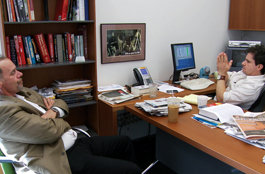

Rossi got great access for his documentary. The blood on the walls from cutbacks and buyouts practically pulsates in 3-D. Here is monkish dedication to the news—and mulish refusal to be sucked into an NBC-led celebration of a phony milestone of the Iraq war. It’s different from the way the trade is seen by vulgarian’s vulgarian Sam Zell of the Tribune Company, or by Gawker Media’s Nick Denton. The former wishes aloud for a porn section in his papers. The latter’s eyes are glued to a big electronic board of gossip, rated by clicks. Maybe the best argument for sparing the Gray Lady is that you’ll never see the following headline there: ÒWas Tia Tequila Attacked With Poo by Jugallos?” (Sentences like that will make future archeologists earn their pay.)
Times reporter Brian Stelter evangelizes for Twitter. We hear hopes that iPads will reproduce the newspaper experience without the paper. The Nation‘s Katrina vanden Heuvel speculates that joint partnerships between nonprofits and the Times will help keep bureaus open. Rossi does a sterling job of explaining the way several important newspapers teamed up to sort through Wikileaks.
Rossi interviews Gay Talese and the New Yorker‘s David Remnick. And he collects footage of professional Eva Gabor imitator and miser Arianna Huffington, crowing over the victory of aggregating media. The indifferently shaved, Werner Herzog-ish media critic David Carr is this documentary’s best source. Carr admits that he’s lived a life with Òtexture”; while at a conference for journalists in his hometown, he shows the cameras the Minneapolis strip club where he bought the coke that got him arrested. Ultimately, Carr makes the best points, defying the electronic glibsters who believe that the Times is being karmically punished for having been the megaphone for W’s war.
Page One: Inside the New York Times
R; 88 min.
Opens July 8.



